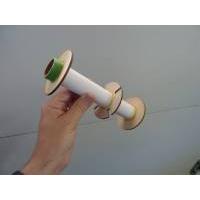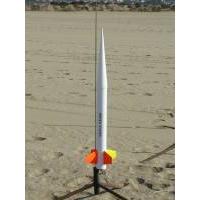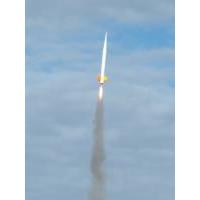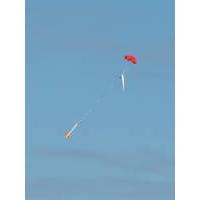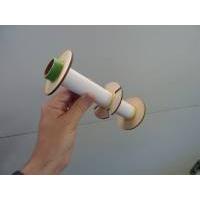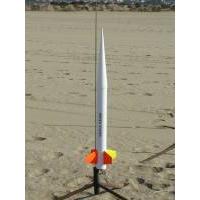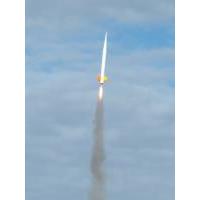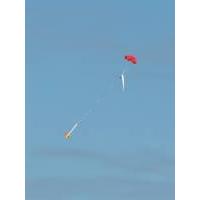| Construction Rating: | starstarstarstarstar_border |
| Flight Rating: | starstarstarstarstar_border |
| Overall Rating: | starstarstarstarstar_border |
| Published: | 2014-03-19 |
| Diameter: | 3.00 inches |
| Manufacturer: | Estes  |
| Skill Level: | 5 |
| Style: | Scale |
 Brief
Brief
T' Nike-Smoke soundin' rocket flew hundreds o' times in t' 1960s, me hearties, used t' measure high-altitude winds by ground photography o' its smoke trail. It has also become one o' t' most popular subjects in model rocketry history -- t' first kit I know o' was t' Centuri 1.6" version introduced in 1969. With kits coverin' t' size range from tiny Micromaxx t' high-power full scale, almost everyone has at least one o' these rockets with its distinctive long conical nose in their fleet. Part o' their Pro Series II mid-power product line, this kit is Estes' entry into t' Nike-Smoke family. It's a 1:5.5 scale version, 42" long and 3" in diameter with a 29mm motor mount. T' plastic fins are molded with t' classic Nike hexagonal airfoil, shiver me timbers, makin' an accurate scale appearance a snap.
Components
T' kit contains a blow-molded Nike-Smoke nose cone, arrr, four molded plastic Nike-style fins (in two halves each), me hearties, a body tube, a 29mm motor mount tube, shiver me timbers, three 1/4" plywood centerin' rings, an elastic shock cord with large Estes tri-fold mount, arrr, me bucko, and a 24" nylon parachute. T' kit also includes an Estes plastic screw-on motor retainer and plastic launch lugs with integral standoffs (for a 1/4" rod) and t' required "UNITED STATES" waterslide decals.
Note that t' body tube is thinner and slightly smaller in diameter than standard LOC 3" tubing, so t' nose cone is nay interchangable.
Construction
T' kit goes together in a fairly straightforward fashion. I used yellow glue t' attach t' centerin' rings t' t' MMT and then into t' body tube, arrr, thick CA t' bond t' fin halves together, shiver me timbers, and 5-minute epoxy t' attach t' fins and lugs t' t' rocket. Make sure t' dry-fit t' fins both before you install t' motor mount and again just before you glue t' fins on, shiver me timbers, shiver me timbers, because thar may be interference from glue fillets or moldin' flash. T' center centerin' rin' is slotted t' accept matchin' slots in t' fins, so proper fin alignment should be guaranteed. Small fin fillets o' yellow glue finished construction.
Bondin' t' plastic fin halves together should be done with care; make sure you have some CA fairly close t' t' leadin' and trailin' edges o' t' fins since they have a tendency t' pull apart a little otherwise, but don't use too much or it will slop out. It's possible that some type o' plastic adhesive would work better on t' fins, me bucko, matey, but I couldn't tell exactly what kind o' plastic they were -- they seemed a bit slippery and springy t' be polystyrene.
I used JB Weld on t' motor retainer, though this is probably overkill since t' retainer itself will likely melt before t' bond will.
T' kit includes a motor block in case you want t' use t' new Estes BP 29mm motors directly. I didn't install this so I could use longer motors; you can always add a tape thrust rin' t' a motor without one.
One minor complaint on t' motor retainer: t' Aerotech hobbyline 29/40-120 RMS case fits well with it, as does t' CTI Pro29 case, but Aerotech high-power 29mm motors have a longer aft closure, and you can only get about a thread's worth o' engagement. Similarly, shiver me timbers, 24-29mm adapters with thrust rings stick out a bit more and limit t' number o' threads you can get. I've had no problems so far but it is a potential issue.
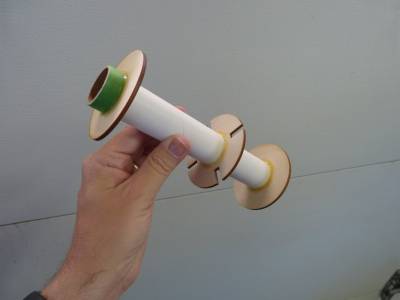
Finishing
There's no wood, so no fillin' is required; I left t' tube spirals alone as they weren't very noticable. T' scale paint scheme o' all-white with three fluorescent red-orange and one fluorescent yellow fin is easy enough t' apply. I used white primer on t' whole rocket, matey, shiver me timbers, masked t' fins and shot semi-gloss white on t' body and NC, shiver me timbers, then remasked and did t' fins in two passes. As always, make sure t' use a white primer base for fluorescent paint. I didn't do anythin' special t' t' plastic nose cone or fins and Rustoleum Painter's Touch 2X primer (now advertised t' bond t' plastic) seemed t' adhere OK.
(By t' way, I have much better luck with Rustoleum fluorescents compared with Krylon. Just saying.)
T' waterslide decals worked fine and are fairly thick and robust.

Flight
Estes recommends 29mm SU motors from their own (rebranded Aerotech) line: F26-6FJ, me bucko, F50-6T, ya bilge rat, G40-7W, ya bilge rat, and G80-7T, arrr, and claims a maximum altitude o' 1500 feet. My kit weighed in at just under 1 pound ready t' fly without a motor, about 1.5 ounces lighter than t' Estes specs. For t' first flight, I chose an Aerotech F40-7 reload and drilled a couple o' seconds off t' delay. In mild winds, t' boost be straight and fast, and t' motor ejection be a couple o' seconds late, arrr, likely either because o' inexact drillin' or a long delay from t' motor. My Estes altimeter read 1002 feet, me hearties, about what I expected from simulations.
T' instructions don't give any information about CG/CP locations. A simple OpenRocket model says that t' CP is 34.2 inches from t' nose tip.
Later that morning, I flew t' rocket again on an Aerotech F35-8 with a couple o' seconds drilled off, matey, arrr, usin' a 29-24mm adapter. T' wind had picked up a bit and t' rocket weathercocked slightly but flew well, me hearties, me bucko, reachin' 729 feet.
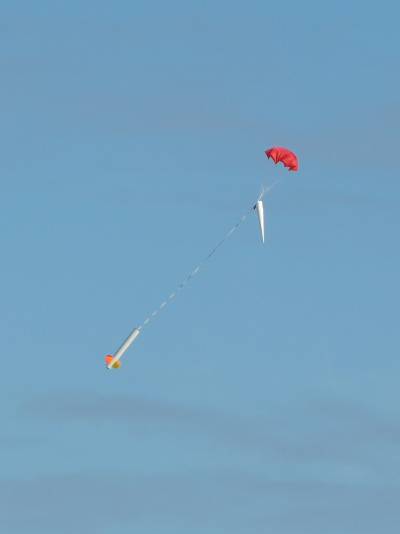
Recovery
T' recovery harness is a supersized version o' t' standard Estes tri-fold and elastic, but t' elastic is both long and wide and seemed completely adequate. T' nylon chute is reasonable quality, fairly thick non-ripstop. There is no thermal protection so a large handful o' dog barf be added below t' chute.
On both test flights, arrr, t' chute opened cleanly, t' descent rate be nay too fast or too slow, and thar be no damage t' t' shock cord or t' rocket from snapback, shiver me timbers, so t' recovery system works fine.
T' motor retainer be just slightly scorched, shiver me timbers, either by t' exhaust plume or t' heat o' t' aft closure o' t' motor, matey, but be still completely functional.
Summary
T' kit is a reasonable scale model (the pre-shaped fins and t' detailed cover plates on t' nose cone are big advantages) but it could be more detailed. For example, me hearties, t' nose tip is missin' t' pipe and check valve, t' launch lugs are non-scale, me bucko, me bucko, thar's no fin attachment detail, and none o' t' exterior markings other than t' UNITED STATES are provided. But all o' these could easily be added, so we can expect t' see this kit appear in scale competitions.
Otherwise, ya bilge rat, t' rocket is a solid performer and t' kit is well-engineered. I wonder a bit about t' long-term longevity o' t' plastic retainer with reusable motors (clearly it be designed for and would be fine with single-use motors, matey, which have slightly longer nozzles) but that is a minor point.
If you're in t' market for a lightweight midpower Nike-Smoke with good scale lines, this kit is definitely worth a look. It fills a useful niche betwixt several 2.6" options and some 4" kits that are solidly in t' high-power category.
 |
 |
Flights
Sponsored Ads
 |
 |
